carpenter ants on:
[Wikipedia]
[Google]
[Amazon]
Carpenter ants (''Camponotus'' spp.) are large ()
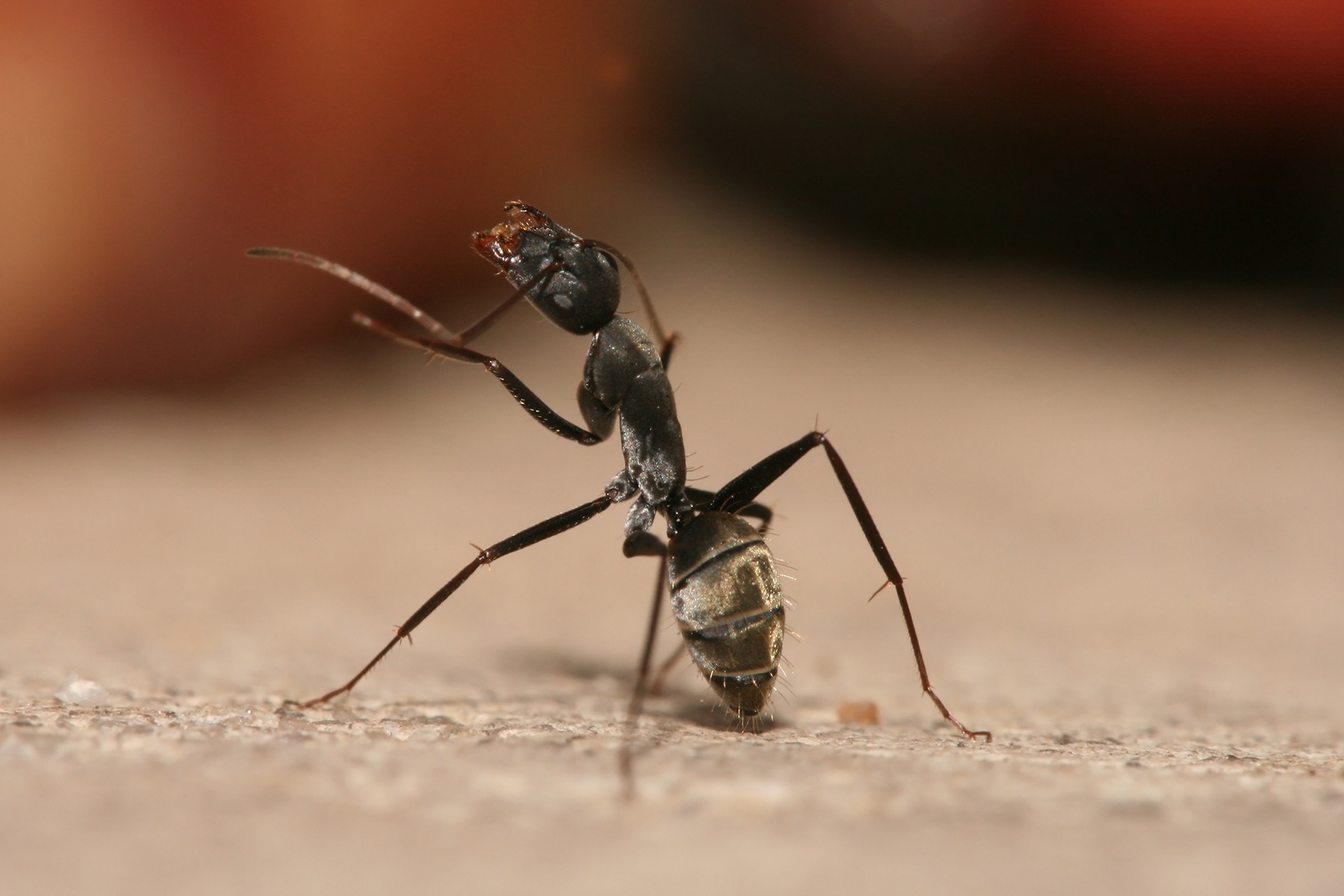 Carpenter ant species reside both outdoors and indoors in moist, decaying, or hollow wood, most commonly in forest environments. They cut "galleries" into the wood grain to provide passageways to allow for movement between different sections of the nest. Certain parts of a house, such as around and under windows, roof eaves, decks and porches, are more likely to be infested by carpenter ants because these areas are most vulnerable to moisture.
Carpenter ant species reside both outdoors and indoors in moist, decaying, or hollow wood, most commonly in forest environments. They cut "galleries" into the wood grain to provide passageways to allow for movement between different sections of the nest. Certain parts of a house, such as around and under windows, roof eaves, decks and porches, are more likely to be infested by carpenter ants because these areas are most vulnerable to moisture.
 Carpenter ants have been known to construct extensive underground tunneling systems. These systems often lead to an end at some food source – often aphid colonies, where the ants extract and feed on honeydew. These tunneling systems also often exist in trees. The colonies typically include a central "parent" colony surrounded and supplemented by smaller satellite colonies.Colony Size and Polygyny in Carpenter Ants (Hymenoptera: Formicidae) Roger D. Akre, Laurel D. Hansen and Elizabeth A. Myhre Journal of the Kansas Entomological Society , Vol. 67, No. 1 (January 1994), pp. 1–9
Carpenter ants have been known to construct extensive underground tunneling systems. These systems often lead to an end at some food source – often aphid colonies, where the ants extract and feed on honeydew. These tunneling systems also often exist in trees. The colonies typically include a central "parent" colony surrounded and supplemented by smaller satellite colonies.Colony Size and Polygyny in Carpenter Ants (Hymenoptera: Formicidae) Roger D. Akre, Laurel D. Hansen and Elizabeth A. Myhre Journal of the Kansas Entomological Society , Vol. 67, No. 1 (January 1994), pp. 1–9
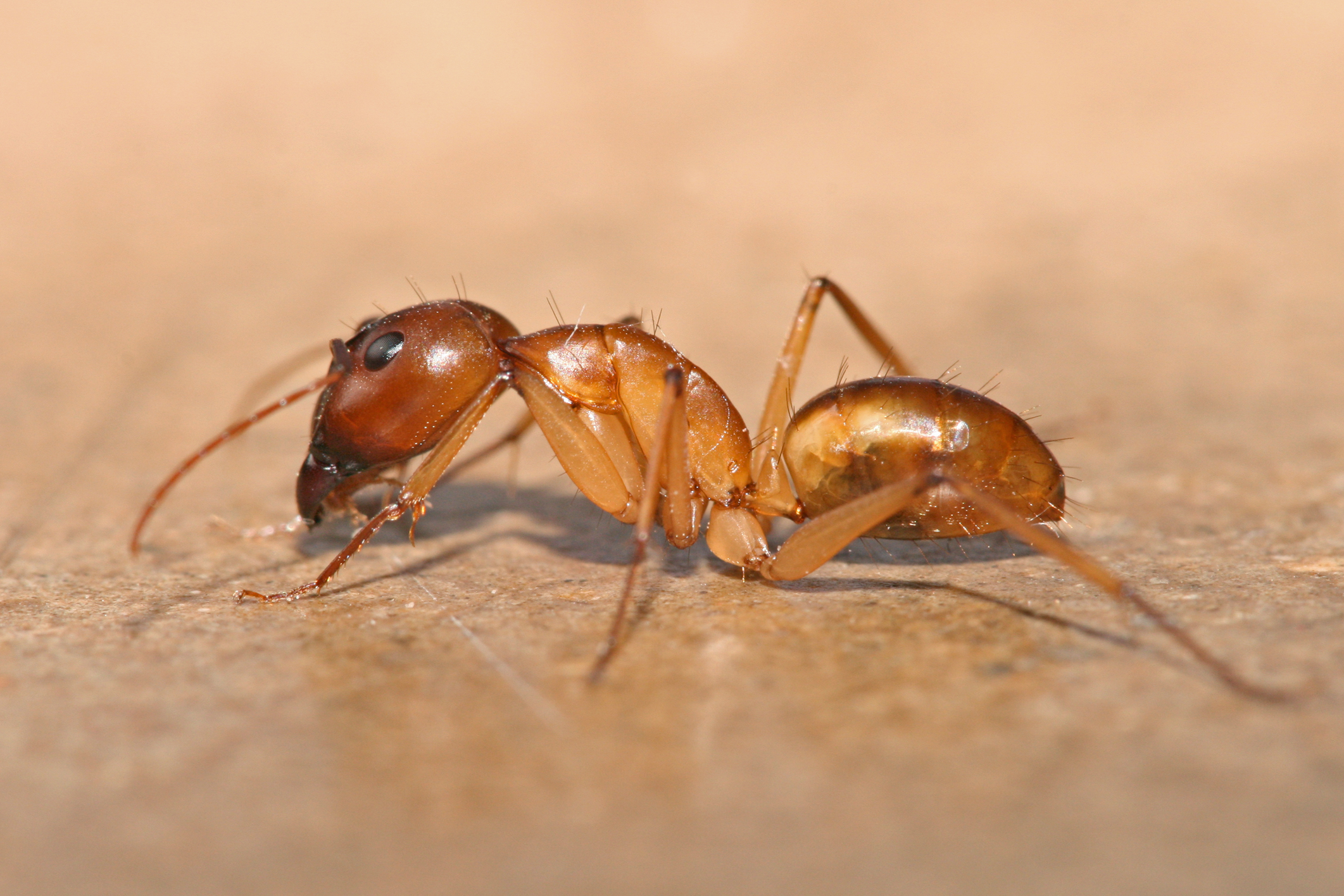 Carpenter ants are considered both predators and scavengers. These ants are foragers that typically eat parts of other dead insects or substances derived from other insects. Common foods for them include insect parts, " honeydew" produced by aphids, or extrafloral nectar from plants. They are also known for eating other sugary liquids such as honey, syrup, or juices. Carpenter ants can increase the survivability of
Carpenter ants are considered both predators and scavengers. These ants are foragers that typically eat parts of other dead insects or substances derived from other insects. Common foods for them include insect parts, " honeydew" produced by aphids, or extrafloral nectar from plants. They are also known for eating other sugary liquids such as honey, syrup, or juices. Carpenter ants can increase the survivability of
 Carpenter ants work to build the nests that house eggs in environments with usually high humidity due to their sensitivity to environmental humidity. These nests are called primary nests. Satellite nests are constructed once the primary nest is established and has begun to mature. Residents of satellite nests include older
Carpenter ants work to build the nests that house eggs in environments with usually high humidity due to their sensitivity to environmental humidity. These nests are called primary nests. Satellite nests are constructed once the primary nest is established and has begun to mature. Residents of satellite nests include older
 In at least nine Southeast Asian species of the ''Cylindricus'' complex, including ''
In at least nine Southeast Asian species of the ''Cylindricus'' complex, including ''
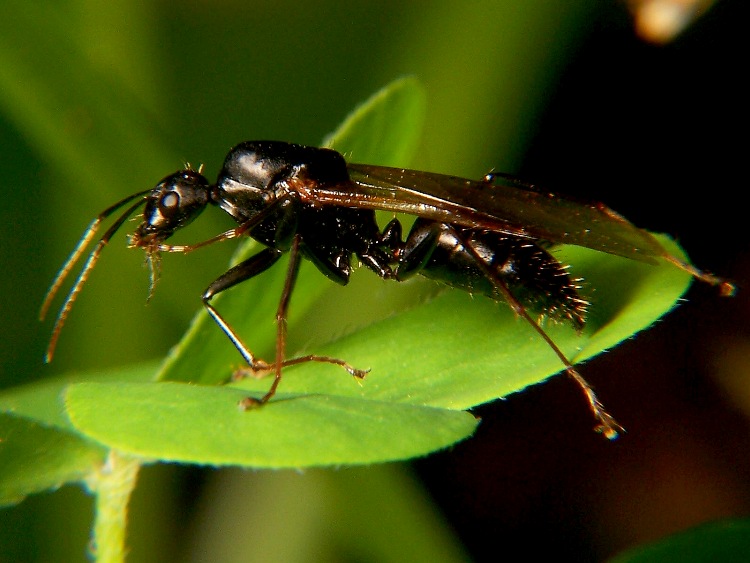
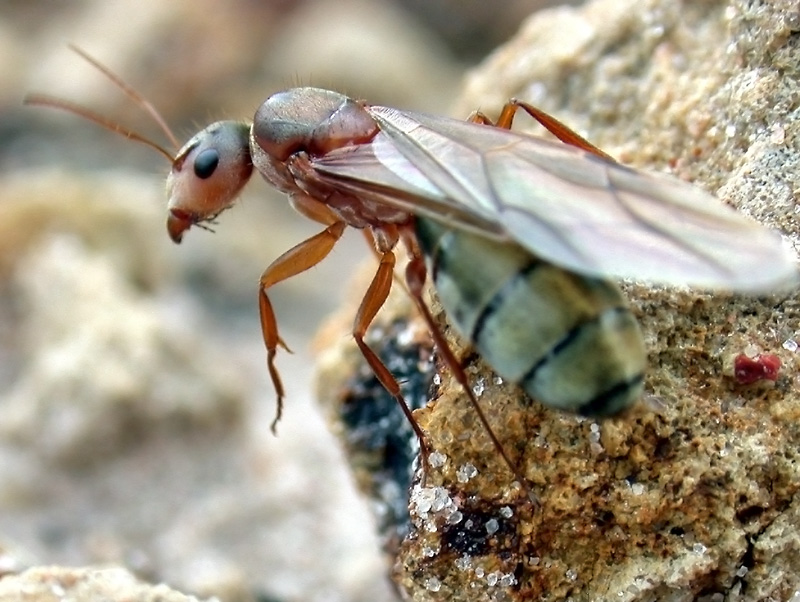


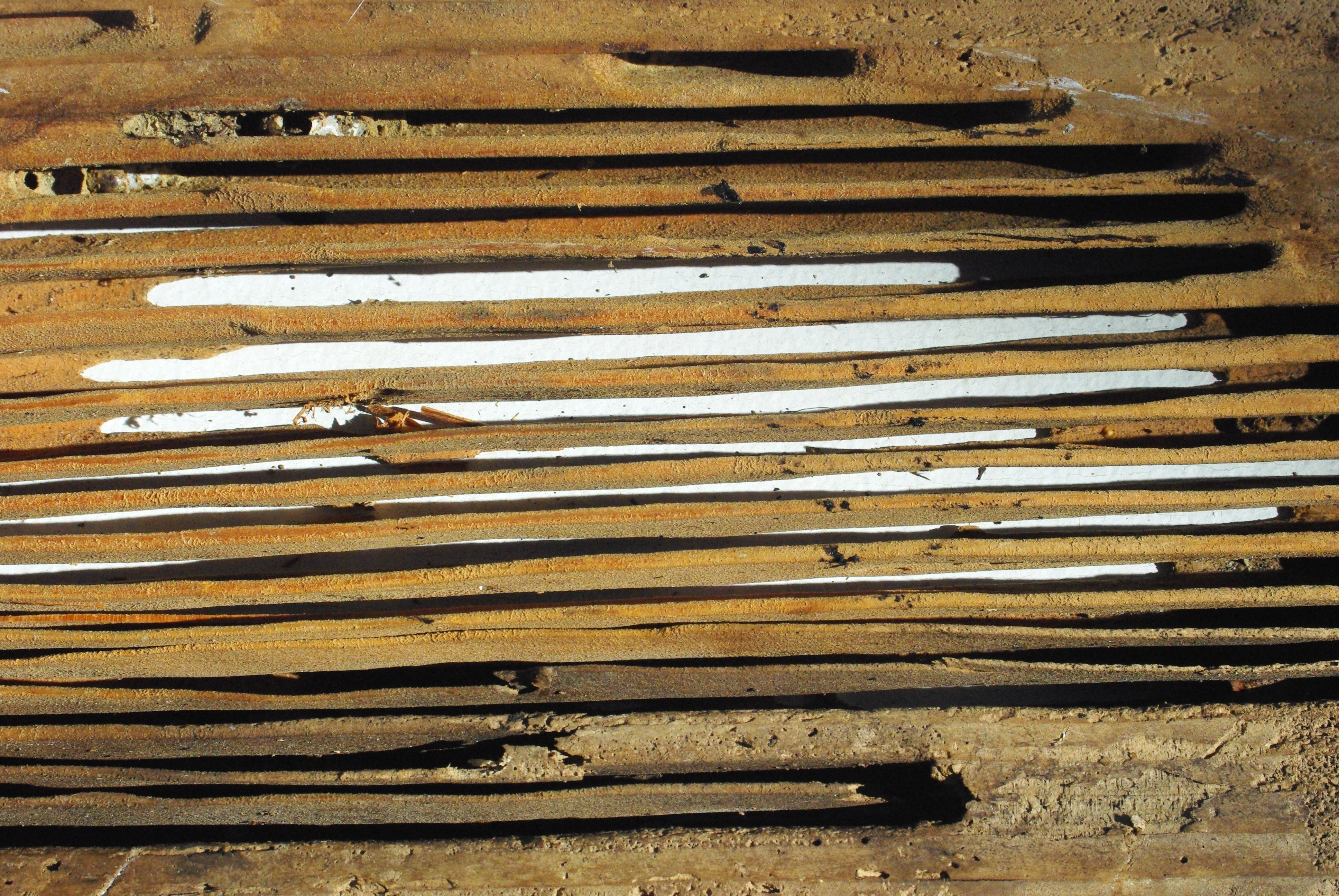 * '' Camponotus aeneopilosus'' Mayr, 1862 – golden tail sugar ant
* '' Camponotus amaurus'' (Espadaler, 1997)
* '' Camponotus americanus''
* '' Camponotus anderseni''
* ''
* '' Camponotus aeneopilosus'' Mayr, 1862 – golden tail sugar ant
* '' Camponotus amaurus'' (Espadaler, 1997)
* '' Camponotus americanus''
* '' Camponotus anderseni''
* ''
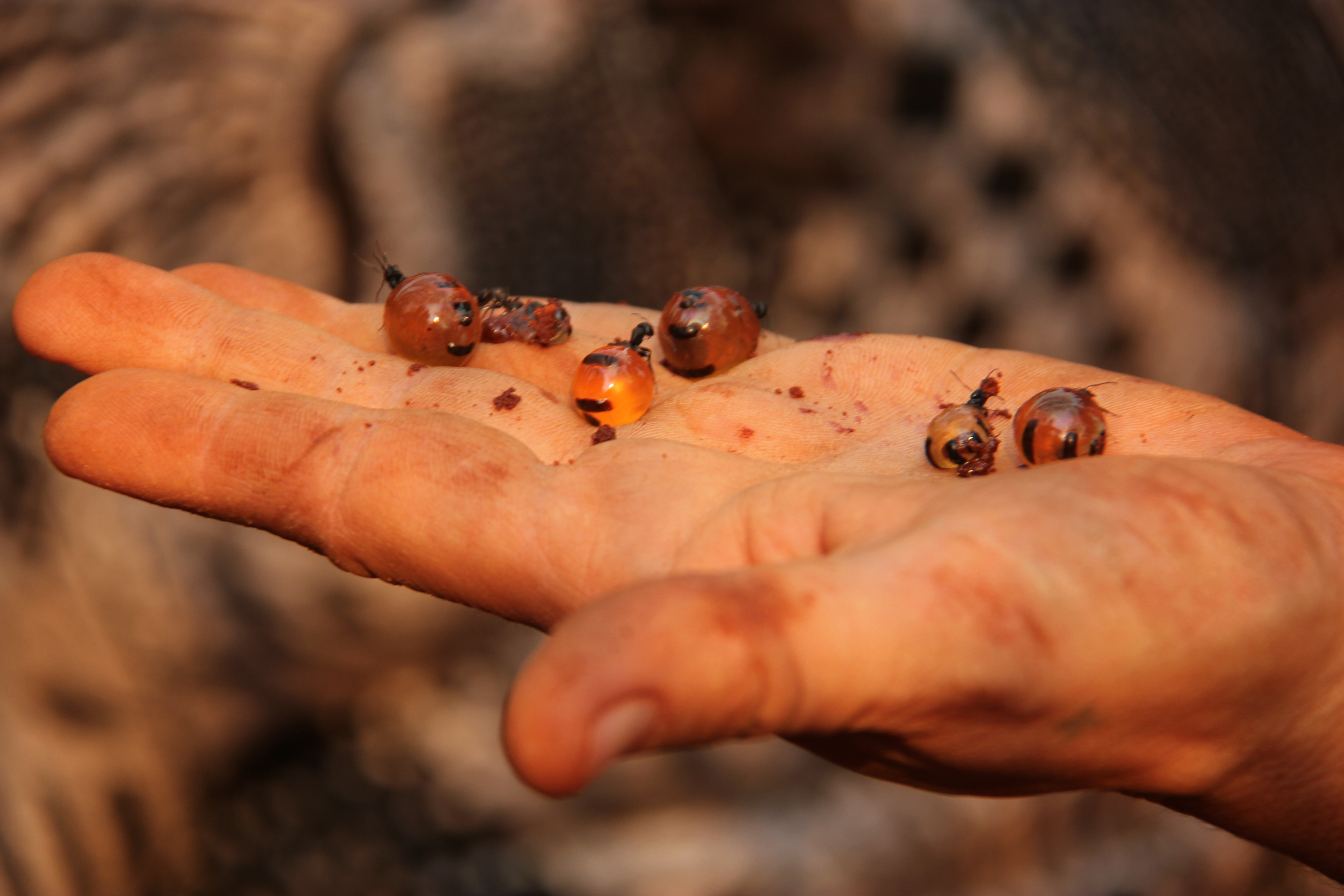 Carpenter ants and their larvae are eaten in various parts of the world. In Australia, the
Carpenter ants and their larvae are eaten in various parts of the world. In Australia, the
PDF
��original description of p. 35 * (2007): A Key to ''Camponotus'' Mayr of Australia. In: Snelling, R.R., B.L. Fisher and P.S. Ward (eds). Advances in ant systematics (Hymenoptera: Formicidae): homage to E. O. Wilson – 50 years of contributions. ''Memoirs of the American Entomological Institute'' 80
PDF
— 91 species, 10 subspecies
Carpenter Ant Information
Ohio State University Extension Fact Sheet
Carpenter Ant Fact Sheet
from the
ant
Ants are eusocial insects of the family Formicidae and, along with the related wasps and bees, belong to the order Hymenoptera. Ants evolved from vespoid wasp ancestors in the Cretaceous period. More than 13,800 of an estimated total of 22,0 ...
s indigenous to many forested parts of the world.
They build nests inside wood consisting of galleries chewed out with their mandibles or jaws, preferably in dead, damp wood. However, unlike termite
Termites are small insects that live in colonies and have distinct castes (eusocial) and feed on wood or other dead plant matter. Termites comprise the infraorder Isoptera, or alternatively the epifamily Termitoidae, within the order Blattode ...
s, they do not consume wood, discarding a material that resembles sawdust outside their nest. Sometimes, carpenter ants hollow out sections of trees. They also commonly infest wooden buildings and structures, and are a widespread problem and major cause of structural damage. Nevertheless, their ability to excavate wood helps in forest decomposition. The genus includes over 1,000 species. They also farm aphid
Aphids are small sap-sucking insects and members of the superfamily Aphidoidea. Common names include greenfly and blackfly, although individuals within a species can vary widely in color. The group includes the fluffy white woolly aphids. A t ...
s. In their farming, the ants protect the aphids from predators (usually other insects) while they excrete a sugary fluid called honeydew, which the ants get by stroking the aphids with their antennae.
Description
''Camponotus'' are generally large ants, with workers being 4-7 mm long in small species or 7-13 mm in large species, queens being 9-20 mm long and males being 5-13 mm long. The bases of the antennae are separated from the clypeal border by a distance of at least the antennal scape's maximum diameter. Themesosoma
The mesosoma is the middle part of the body, or tagma, of arthropods whose body is composed of three parts, the other two being the prosoma and the metasoma. It bears the legs, and, in the case of winged insects, the wings.
In hymenopterans of t ...
in profile usually forms a continuous curve from the pronotum
The prothorax is the foremost of the three segments in the thorax of an insect, and bears the first pair of legs. Its principal sclerites (exoskeletal plates) are the pronotum ( dorsal), the prosternum (ventral), and the propleuron ( lateral) on ...
through to the propodeum.
Habitat
 Carpenter ant species reside both outdoors and indoors in moist, decaying, or hollow wood, most commonly in forest environments. They cut "galleries" into the wood grain to provide passageways to allow for movement between different sections of the nest. Certain parts of a house, such as around and under windows, roof eaves, decks and porches, are more likely to be infested by carpenter ants because these areas are most vulnerable to moisture.
Carpenter ant species reside both outdoors and indoors in moist, decaying, or hollow wood, most commonly in forest environments. They cut "galleries" into the wood grain to provide passageways to allow for movement between different sections of the nest. Certain parts of a house, such as around and under windows, roof eaves, decks and porches, are more likely to be infested by carpenter ants because these areas are most vulnerable to moisture.
 Carpenter ants have been known to construct extensive underground tunneling systems. These systems often lead to an end at some food source – often aphid colonies, where the ants extract and feed on honeydew. These tunneling systems also often exist in trees. The colonies typically include a central "parent" colony surrounded and supplemented by smaller satellite colonies.Colony Size and Polygyny in Carpenter Ants (Hymenoptera: Formicidae) Roger D. Akre, Laurel D. Hansen and Elizabeth A. Myhre Journal of the Kansas Entomological Society , Vol. 67, No. 1 (January 1994), pp. 1–9
Carpenter ants have been known to construct extensive underground tunneling systems. These systems often lead to an end at some food source – often aphid colonies, where the ants extract and feed on honeydew. These tunneling systems also often exist in trees. The colonies typically include a central "parent" colony surrounded and supplemented by smaller satellite colonies.Colony Size and Polygyny in Carpenter Ants (Hymenoptera: Formicidae) Roger D. Akre, Laurel D. Hansen and Elizabeth A. Myhre Journal of the Kansas Entomological Society , Vol. 67, No. 1 (January 1994), pp. 1–9
Food
 Carpenter ants are considered both predators and scavengers. These ants are foragers that typically eat parts of other dead insects or substances derived from other insects. Common foods for them include insect parts, " honeydew" produced by aphids, or extrafloral nectar from plants. They are also known for eating other sugary liquids such as honey, syrup, or juices. Carpenter ants can increase the survivability of
Carpenter ants are considered both predators and scavengers. These ants are foragers that typically eat parts of other dead insects or substances derived from other insects. Common foods for them include insect parts, " honeydew" produced by aphids, or extrafloral nectar from plants. They are also known for eating other sugary liquids such as honey, syrup, or juices. Carpenter ants can increase the survivability of aphids
Aphids are small sap-sucking insects and members of the superfamily Aphidoidea. Common names include greenfly and blackfly, although individuals within a species can vary widely in color. The group includes the fluffy white woolly aphids. A t ...
when they tend them. They tend many aphid species but can also express preference for specific ones.
Most species of carpenter ants forage at night. When foraging, they usually collect and consume dead insects. Some species less commonly collect live insects. When they discover a dead insect, workers surround it and extract its bodily fluids to be carried back to the nest. The remaining chitin-based shell is left behind. Occasionally, the ants bring the chitinous head of the insect back to the nest, where they also extract its inner tissue. The ants can forage individually or in small or large groups, though they often opt to do so individually. Different colonies in close proximity may have overlapping foraging regions, although they typically do not assist each other in foraging. Their main food sources normally include proteins and carbohydrates.
Instances of carpenter ants bleeding Chinese elm trees for the sap have been observed in the northern Arizona region. These instances may be rare as the colonies vastly exceeded the standard size of carpenter ant colonies elsewhere.
When workers find food sources, they communicate this information to the rest of the nest. They use biochemical pheromones to mark the shortest path that can be taken from the nest to the source. When a sizable number of workers follows this trail, the strength of the cue increases and a foraging trail is established. This ends when the food source is depleted. The workers will then feed the queen and the larvae by consuming the food they have found, and regurgitating (trophallaxis) the food at the nest. Foraging trails can either be under or above ground.
Although carpenter ants do not tend to be extremely aggressive, they have developed mechanisms to maximize their provision from a food source when that same food source is visited by a competing organism. This is accomplished in different ways. Sometimes they colonize an area near a relatively static food supply. More often, they develop a systemic way to visit the food source with alternating trips by different individual ants or groups. This allows them to decrease the gains of intruders because the intruders tend to visit in a scattered, random, and unorganized manner. The ants, however, visit the sources systematically such that they lower the mean standing crop. They tend to visit more resource-dense food areas in an attempt to minimize resource availability for others. That is, the more systematic the foraging behavior of the ants, the more random that of its competitors.
Contrary to popular belief, carpenter ants do not actually eat wood because they are unable to digest cellulose
Cellulose is an organic compound with the formula , a polysaccharide consisting of a linear chain of several hundred to many thousands of β(1→4) linked D-glucose units. Cellulose is an important structural component of the primary cell wall ...
. They only create tunnels and nests within it.
Some carpenter ant species can obtain nitrogen by feeding on urine
Urine is a liquid by-product of metabolism in humans and in many other animals. Urine flows from the kidneys through the ureters to the urinary bladder. Urination results in urine being excreted from the body through the urethra.
Cellular m ...
or urine-stained sand. This may be beneficial in nitrogen-limited environments.
Symbionts
All ants in this genus, and some related genera, possess anobligate {{wiktionary, obligate
As an adjective, obligate means "by necessity" (antonym '' facultative'') and is used mainly in biology in phrases such as:
* Obligate aerobe, an organism that cannot survive without oxygen
* Obligate anaerobe, an organism tha ...
bacterial endosymbiont called ''Blochmannia
''Blochmannia'' is a genus of symbiotic bacteria found in carpenter ant. There are over 1000 species of these ants and, as of 2014, of the over 30 species of carpenter ant that have been investigated, all contain some form of ''Blochmannia''. ...
''. This bacterium has a small genome, and retains genes to biosynthesize essential amino acid
Amino acids are organic compounds that contain both amino and carboxylic acid functional groups. Although hundreds of amino acids exist in nature, by far the most important are the alpha-amino acids, which comprise proteins. Only 22 alpha am ...
s and other nutrients. This suggests the bacterium plays a role in ant nutrition. Many ''Camponotus'' species are also infected with ''Wolbachia
''Wolbachia'' is a genus of intracellular bacteria that infects mainly arthropod species, including a high proportion of insects, and also some nematodes. It is one of the most common parasitic microbes, and is possibly the most common reprodu ...
'', another endosymbiont that is widespread across insect groups. ''Wolbachia'' is associated with the nurse cells in the queen's ovaries in the species ''Camponotus textor'', which results in the worker larva being infected.
Behavior and ecology
Nesting
 Carpenter ants work to build the nests that house eggs in environments with usually high humidity due to their sensitivity to environmental humidity. These nests are called primary nests. Satellite nests are constructed once the primary nest is established and has begun to mature. Residents of satellite nests include older
Carpenter ants work to build the nests that house eggs in environments with usually high humidity due to their sensitivity to environmental humidity. These nests are called primary nests. Satellite nests are constructed once the primary nest is established and has begun to mature. Residents of satellite nests include older larvae
A larva (; plural larvae ) is a distinct juvenile form many animals undergo before metamorphosis into adults. Animals with indirect development such as insects, amphibians, or cnidarians typically have a larval phase of their life cycle.
Th ...
, pupae, and some winged individuals. Only eggs, the newly hatched larvae
A larva (; plural larvae ) is a distinct juvenile form many animals undergo before metamorphosis into adults. Animals with indirect development such as insects, amphibians, or cnidarians typically have a larval phase of their life cycle.
Th ...
, workers, and the queen reside in the primary nests. As satellite nests do not have environmentally sensitive eggs, the ants can construct them in rather diverse locations that can actually be relatively dry. Some species, like ''Camponotus vagus
''Camponotus vagus'' is a species of large, black, Palaearctic carpenter ant with a wide range that includes much of Europe, a large area of Asia, and part of Africa.
Description
''Camponotus vagus'' is a relatively distinctive species that is ...
'', build the nest in a dry place, usually in wood.
Nuptial flight
When conditions are warm and humid, winged males and females participate in anuptial flight
Nuptial flight is an important phase in the reproduction of most ant, termite, and some bee species. It is also observed in some fly species, such as ''Rhamphomyia longicauda''.
During the flight, virgin queens mate with males and then land to ...
. They emerge from their satellite nests and females mate with a number of males while in flight. The males die after mating. These newly fertilized queens discard their wings and search for new areas to establish primary nests. The queens build new nests and deposit around 20 eggs, nurturing them as they grow until worker ants emerge. The worker ants eventually assist her in caring for the brood as she lays more eggs. After a few years, reproductive winged ants are born, allowing for the making of new colonies. Again, satellite nests will be established and the process will repeat itself.Pararas — Carayannis, Carolyn. "Carpenter Ants". Colony Behaviors of Carpenter Ants. Web. October 1, 2013.
Relatedness
Relatedness
The coefficient of relationship is a measure of the degree of consanguinity (or biological relationship) between two individuals. The term coefficient of relationship was defined by Sewall Wright in 1922, and was derived from his definition of t ...
is the probability that a gene in one individual is an identical copy, by descent, of a gene in another individual. It is essentially a measure of how closely related two individuals are with respect to a gene. It is quantified by the coefficient of relatedness, which is a number between zero and one. The larger the value, the more two individuals are "related". Carpenter ants are social hymenopteran insects. This means the relatedness between offspring and parents is disproportionate. Females are more closely related to their sisters than they are to their offspring. Between full sisters, the coefficient of relatedness is ''r'' > 0.75 (due to their haplodiploid
Haplodiploidy is a sex-determination system in which males develop from unfertilized eggs and are haploid, and females develop from fertilized eggs and are diploid. Haplodiploidy is sometimes called arrhenotoky.
Haplodiploidy determines the sex ...
genetic system). Between parent and offspring, the coefficient of relatedness is ''r'' = 0.5, because, given the event in meiosis, a certain gene has a 50% chance of being passed on to the offspring. The level of relatedness is an important dictator of individual interactions.
Genetic diversity
Eusocial insects tend to present lowgenetic diversity
Genetic diversity is the total number of genetic characteristics in the genetic makeup of a species, it ranges widely from the number of species to differences within species and can be attributed to the span of survival for a species. It is dis ...
within colonies, which can increase with the co-occurrence of multiple queens ( polygyny) or with multiple mating by a single queen (polyandry
Polyandry (; ) is a form of polygamy in which a woman takes two or more husbands at the same time. Polyandry is contrasted with polygyny, involving one male and two or more females. If a marriage involves a plural number of "husbands and wives" ...
). Distinct reproductive strategies may generate similar patterns of genetic diversity in ants.
Kin recognition
According to Hamilton's rule for relatedness, for relative-specific interactions to occur, such as kinaltruism
Altruism is the principle and moral practice of concern for the welfare and/or happiness of other human beings or animals, resulting in a quality of life both material and spiritual. It is a traditional virtue in many cultures and a core as ...
, a high level of relatedness is necessary between two individuals. Carpenter ants, like many social insect species, have mechanisms by which individuals determine whether others are nestmates or not. They are useful because they explain the presence or absence of altruistic behavior between individuals. They also act as evolutionary strategies to help prevent incest and promote kin selection. Social carpenter ants recognize their kin in many ways. These methods of recognition are largely chemical in nature, and include environmental odors, pheromones, "transferable labels", and labels from the queen that are distributed to and among nest members. Because they have a chemical basis for emission and recognition, odors are useful because many ants can detect such changes in their environment through their antennae. This allows acceptance of nestmates and rejection of non-nestmates.
The process of recognition for carpenter ants requires two events. First, a cue must be present on a "donor animal". These cues are called "labels". Next, the receiving animal must be able to recognize and process the cue. In order for an individual carpenter ant to be recognized as a nestmate, it must, as an adult, go through specific interactions with older members of the nest. This process is also necessary in order for the ant to recognize and distinguish other individuals. If these interactions do not occur in the beginning of adult life, the ant will be unable to be distinguished as a nestmate and unable to distinguish nestmates.
Kin altruism
Recognition allows for the presence of kin-specific interactions, such as kin altruism. Altruistic individuals increase other individuals' fitness at the expense of their own. Carpenter ants perform altruistic actions toward their nestmates so that their shared genes are propagated more readily or more often. In many social insect species like these ants, many worker animals are sterile and do not have the ability to reproduce. As a result, they forgo reproduction to donate energy and help the fertile individuals reproduce.Pheromones
As in most other social insect species, individual interaction is heavily influenced by the queen. The queen can influence individuals with odors called pheromones, which can have different effects. Some pheromones have been known to calm workers, while others have been known to excite them. Pheromonal cues from ovipositing queens have a stronger effect on worker ants than those of virgin queens.Social immunity
In many social insect species, social behavior can increase the disease resistance of animals. This phenomenon, called social immunity, exists in carpenter ants. It is mediated through the feeding of other individuals by regurgitation. The regurgitate can have antimicrobial activity, which would be spread amongst members of the colony. Someproteases
A protease (also called a peptidase, proteinase, or proteolytic enzyme) is an enzyme that catalyzes (increases reaction rate or "speeds up") proteolysis, breaking down proteins into smaller polypeptides or single amino acids, and spurring the form ...
with antimicrobial activity have been found to exist in regurgitated material. Communal sharing of immune response capability is likely to play a large role in colonial maintenance during highly pathogenic periods.
Polygyny
Polygyny often is associated with many social insect species, and usually is characterized by limited mating flights, small queen size, and other characteristics. However, carpenter ants have "extensive" mating flights and relatively large queens, distinguishing them from polygynous species. Carpenter ants are described as oligogynous because they have a number of fertile queens which are intolerant of each other and must therefore spread to different areas of the nest. Some aggressive interactions have been known to take place between queens, but not necessarily through workers. Queens become aggressive mainly to other queens if they trespass on a marked territory. Queens in a given colony can work together in brood care and the workers tend to experience higher rates of survival in colonies with multiple queens. Some researchers still subscribe to the notion that carpenter ant colonies are only monogynous.Exploding ants
 In at least nine Southeast Asian species of the ''Cylindricus'' complex, including ''
In at least nine Southeast Asian species of the ''Cylindricus'' complex, including ''Camponotus saundersi
''Colobopsis saundersi'', synonym ''Camponotus saundersi'', is a species of ant found in Malaysia and Brunei, belonging to the genus '' Colobopsis''. A worker can explode suicidally and aggressively as an ultimate act of defense, an ability it h ...
'', workers feature greatly enlarged mandibular glands that run the entire length of the ant's body. They can release their contents suicidally by performing autothysis Autothysis (from the Greek roots ''autos-'' "self" and ''thysia'' "sacrifice") or suicidal altruism is the process where an animal destroys itself via an internal rupturing or explosion of an organ which ruptures the skin. The term was proposed by ...
, thereby rupturing the ant's body and spraying toxic substance from the head, which gives these species the common name "exploding ants." The enlarged mandibular
In anatomy, the mandible, lower jaw or jawbone is the largest, strongest and lowest bone in the human facial skeleton. It forms the lower jaw and holds the lower teeth in place. The mandible sits beneath the maxilla. It is the only movable bone ...
gland, which is many times the size of that of a normal ant, produces a glue. The glue bursts out and entangles and immobilizes all nearby victims.
The termite species ''Globitermes sulphureus
''Globitermes sulphureus'' (suicidal attack ants) is a species of termite that is very common in central and southern Vietnam and also present in other areas of South East Asia, including Cambodia, Thailand, and Peninsular Malaysia. They live in ...
'' has a similar defensive system.
Selected species




Camponotus atriceps
''Camponotus atriceps'', previously referred as ''C. abdominalis'', is a species of carpenter ant, endemic to the Americas.
Habitat
It has been found in a variety of moist and forested habitats, including wet lowland and rainforest, tropical ra ...
'' – Florida carpenter ant (cf. ''C. floridanus'')
* '' Camponotus bishamon''
* '' Camponotus chromaiodes'' – red carpenter ant
* '' Camponotus cinctellus'' – shiny sugar ant
* '' Camponotus compressus'' ( Fabricius, 1787)
* ''Camponotus consobrinus
The banded sugar ant (''Camponotus consobrinus''), also known as the sugar ant, is a species of ant native to Australia. A member of the genus '' Camponotus'' in the subfamily Formicinae, it was described by German entomologist Wilhelm Ferdin ...
'' – banded sugar ant
* '' Camponotus crassus'' Mayr, 1862
* '' Camponotus cruentatus'' (Latreille, 1802)
* '' Camponotus daitoensis''
* '' Camponotus detritus'' Emery, 1886 – Namib Desert dune ant
* '' Camponotus empedocles'' – glossy sugar ant
* ''Camponotus fellah
''Camponotus fellah'' is a species of ant in the subfamily Formicinae found across the Middle East and North Africa. This species was formally described by Dalla Torre in 1893. A ''C. fellah'' queen holds the record for Israeli ant longevity, sur ...
'' (Dalla Torre, 1983)
* '' Camponotus ferrugineus'' – red carpenter ant
* '' Camponotus festinatus'' ( Buckley, 1866)
* '' Camponotus flavomarginatus'' Mayr, 1862
* ''Camponotus floridanus
''Camponotus floridanus'', or Florida carpenter ant, is a species of ant in the genus '' Camponotus''. First described as ''Formica floridana'' by Buckley in 1866, the species was moved to '' Camponotus'' by Mayr in 1886. The ant is widespread ...
'', Florida carpenter ant, genome 90% sequenced
* '' Camponotus haroi'' (Espadaler, 1997)
* '' Camponotus herculeanus'' ( Linnaeus, 1758
Events
January–March
* January 1 – Swedish biologist Carl Linnaeus (Carl von Linné) publishes in Stockholm the first volume (''Animalia'') of the 10th edition of ''Systema Naturae'', the starting point of modern zoological ...
) – Hercules ant
* ''Camponotus japonicus
''Camponotus japonicus'', commonly known as the Japanese carpenter ant, is a species of ant native to eastern Asia. It is black, and one of the largest ants. A nest has about ten to thousands of individuals, and it can be a pest when it enter ...
'' Mayr, 1866 – Japanese carpenter ant
* '' Camponotus kaura''
* '' Camponotus ligniperda'', a common species in Europe
* '' Camponotus modoc'' Wheeler, W. M., 1910 – western carpenter ant
* '' Camponotus monju''
* '' Camponotus nearcticus'' (Emery) – smaller carpenter ant
* '' Camponotus nigriceps'' (Smith, 1858) – black-headed sugar ant
* ''Camponotus novaeboracensis
''Camponotus novaeboracensis'', the New York carpenter ant, is a species of ant in the family Formicidae. It is found in the Nearctic.
References
Further reading
*
*
novaeboracensis
Articles created by Qbugbot
Insects described in ...
''
* '' Camponotus pennsylvanicus'' (DeGeer) – black carpenter ant
* '' Camponotus reburrus'' Mackay, in Mackay & Barriga, 2012
* '' Camponotus punctulatus'' (Mayr) – Tacuru ant
* ''Camponotus saundersi
''Colobopsis saundersi'', synonym ''Camponotus saundersi'', is a species of ant found in Malaysia and Brunei, belonging to the genus '' Colobopsis''. A worker can explode suicidally and aggressively as an ultimate act of defense, an ability it h ...
''
* '' Camponotus schmitzi'' Stärke, 1933 – diving ant
* '' Camponotus sericeiventris''
* ''Camponotus sericeus
''Camponotus sericeus'' is a species of carpenter ant
Carpenter ants (''Camponotus'' spp.) are large () ants indigenous to many forested parts of the world.
They build nests inside wood consisting of galleries chewed out with their mandi ...
''
* '' Camponotus silvestrii'' Emery, 1906
* '' Camponotus taino''
* ''Camponotus tortuganus
''Camponotus tortuganus'' is a species of ant in the family Formicidae.
References
Further reading
*
tortuganus
Articles created by Qbugbot
Insects described in 1895
{{ant-stub ...
'' (Emery) – Tortugas carpenter ant
* '' Camponotus triodiae''
* '' Camponotus universitatis'' Forel, 1890
* ''Camponotus vagus
''Camponotus vagus'' is a species of large, black, Palaearctic carpenter ant with a wide range that includes much of Europe, a large area of Asia, and part of Africa.
Description
''Camponotus vagus'' is a relatively distinctive species that is ...
'' Scopoli, 1763
* '' Camponotus variegatus'' (Smith, F., 1858) – Hawaiian carpenter ant
Relationship with humans
One of the most familiar species associated with human habitation in the United States is theblack carpenter ant
The black carpenter ant (''Camponotus pennsylvanicus'') is one of the largest and most common species of carpenter ant native to the central and eastern United States as well as eastern Canada.
Description
''C. pennsylvanicus'' can be disting ...
(''Camponotus pennsylvanicus'').
As pests
Carpenter ants can damage wood used in the construction of buildings. They can leave behind a sawdust-like material calledfrass
Frass refers loosely to the more or less solid excreta of insects, and to certain other related matter.
Definition and etymology
''Frass'' is an informal term and accordingly it is variously used and variously defined. It is derived from the ...
that provides clues to their nesting location. Carpenter ant galleries are smooth and very different from termite
Termites are small insects that live in colonies and have distinct castes (eusocial) and feed on wood or other dead plant matter. Termites comprise the infraorder Isoptera, or alternatively the epifamily Termitoidae, within the order Blattode ...
-damaged areas, which have mud packed into the hollowed-out areas. Carpenter ants can be identified by the general presence of one upward protruding node, looking like a spike, at the "waist" attachment between the thorax and abdomen (petiole). Control involves application of insecticides in various forms including dusts and liquids. The dusts are injected directly into galleries and voids where the carpenter ants are living. The liquids are applied in areas where foraging ants are likely to pick the material up and spread the poison to the colony upon returning.
As food
 Carpenter ants and their larvae are eaten in various parts of the world. In Australia, the
Carpenter ants and their larvae are eaten in various parts of the world. In Australia, the Honeypot ant
Honeypot ants, also called honey ants, are ants which have specialised workers (repletes, plerergates, or rotunds) that are gorged with food to the point that their abdomens swell enormously. Other ants then extract nourishment from them, through ...
('' Camponotus inflatus'') is regularly eaten raw by Indigenous Australians. It is a particular favourite source of sugar for Australian Aborigines living in arid regions, partially digging up their nests instead of digging them up entirely, in order to preserve this food source. In North America, lumbermen during the early years in Maine would eat carpenter ants to prevent scurvy, and in John Muir
John Muir ( ; April 21, 1838December 24, 1914), also known as "John of the Mountains" and "Father of the National Parks", was an influential Scottish-American naturalist, author, environmental philosopher, botanist, zoologist, glaciologist, a ...
's publication, '' First Summer in the Sierra'', Muir notes that the Northern Paiute people
Northern may refer to the following:
Geography
* North, a point in direction
* Northern Europe, the northern part or region of Europe
* Northern Highland, a region of Wisconsin, United States
* Northern Province, Sri Lanka
* Northern Range, a ...
of California ate the tickling, acid gasters of the large jet-black carpenter ants. In Africa
Africa is the world's second-largest and second-most populous continent, after Asia in both cases. At about 30.3 million km2 (11.7 million square miles) including adjacent islands, it covers 6% of Earth's total surface area ...
, carpenter ants are among a vast number of species that are consumed by the San people
The San peoples (also Saan), or Bushmen, are members of various Khoe, Tuu, or Kxʼa-speaking indigenous hunter-gatherer cultures that are the first cultures of Southern Africa, and whose territories span Botswana, Namibia, Angola, Zambia, ...
.
References
Cited texts
* * * *Further reading
* (1861): Die europäischen Formiciden. Vienna��original description of p. 35 * (2007): A Key to ''Camponotus'' Mayr of Australia. In: Snelling, R.R., B.L. Fisher and P.S. Ward (eds). Advances in ant systematics (Hymenoptera: Formicidae): homage to E. O. Wilson – 50 years of contributions. ''Memoirs of the American Entomological Institute'' 80
— 91 species, 10 subspecies
External links
Carpenter Ant Information
Ohio State University Extension Fact Sheet
Carpenter Ant Fact Sheet
from the
National Pest Management Association
The National Pest Management Association (NPMA), is a non-profit trade association founded in 1933 that represents the interests of the professional pest management and pest control industries in the United States.Carpenter Ants
An online supplemental to "Carpenter Ants: Biology and Control" by Laurel Hansen, Ph.D. of Spokane Falls Community College {{Taxonbar, from=Q157875 Ant genera Taxa named by Gustav Mayr
An online supplemental to "Carpenter Ants: Biology and Control" by Laurel Hansen, Ph.D. of Spokane Falls Community College {{Taxonbar, from=Q157875 Ant genera Taxa named by Gustav Mayr